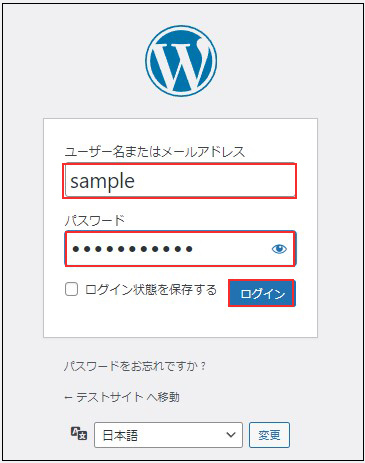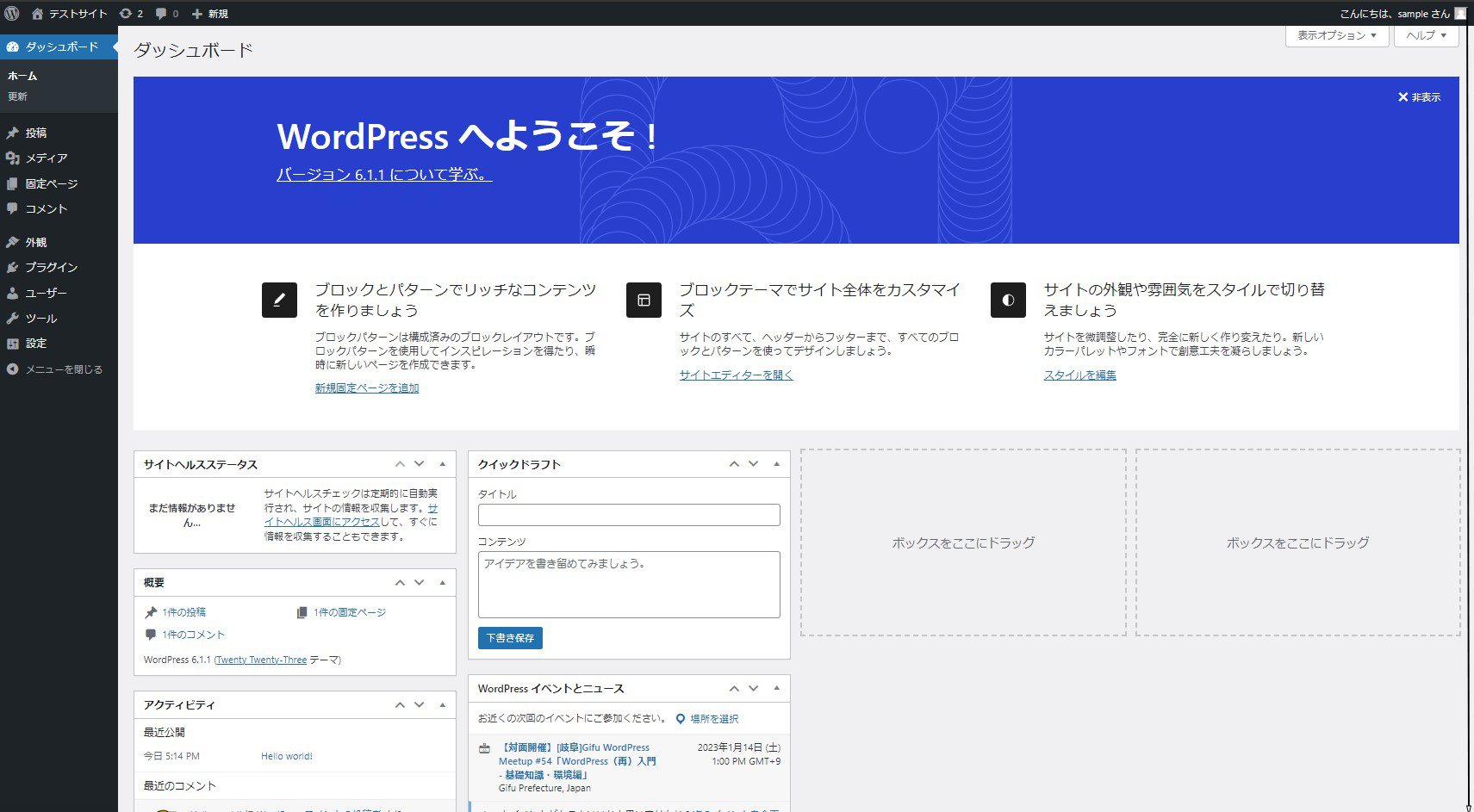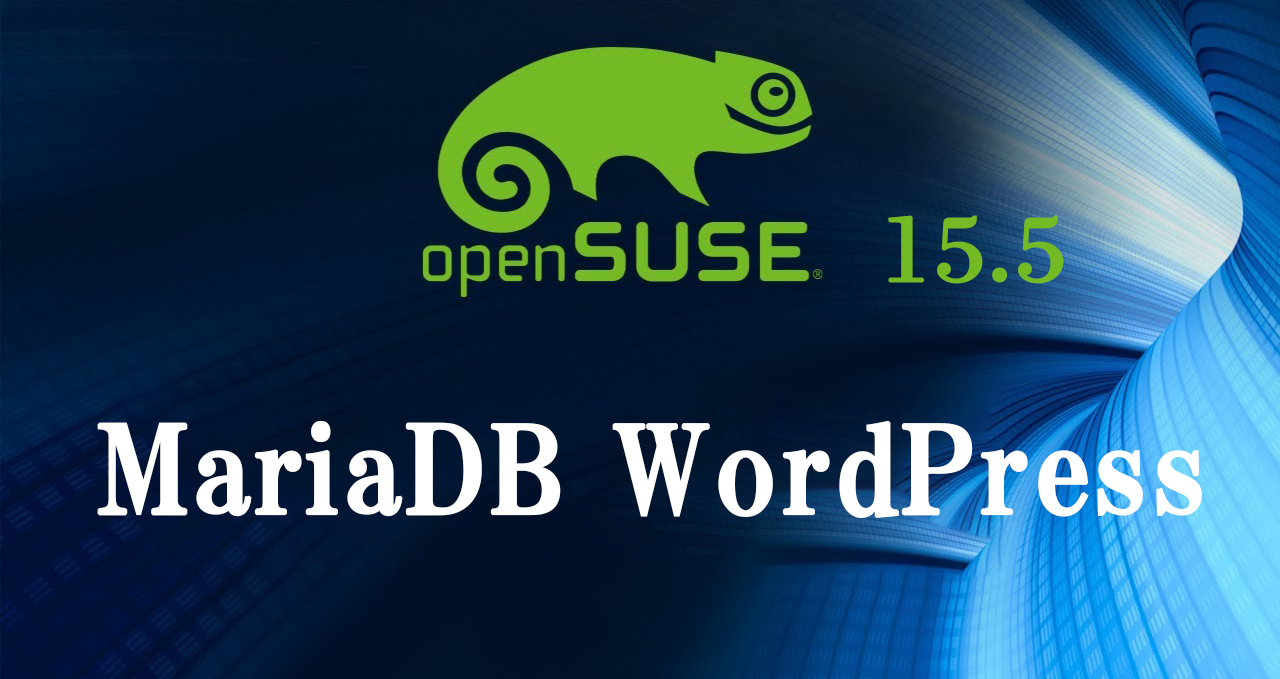Contents
1. MariaDBインストール
サーバーのパッケージを更新します
|
1 2 |
# zypper ref # zypper up -y |
1.1 MariaDB インストール
①インストール
|
1 |
# zypper -n install mariadb |
②初期設定
|
1 2 3 4 |
# vi /etc/my.cnf # 12行目 追記 [mysqld] character-set-server=utf8 |
③インストールされているか確認
|
1 2 3 4 5 6 7 8 9 10 11 12 13 14 15 16 17 18 19 20 21 22 23 24 25 |
# rpm -qi mariadb Name : mariadb Version : 10.6.13 Release : 150400.3.23.1 Architecture: x86_64 Install Date: Tue Jun 13 16:50:16 2023 Group : Productivity/Databases/Servers Size : 148231326 License : SUSE-GPL-2.0-with-FLOSS-exception Signature : RSA/SHA256, Thu May 25 01:12:04 2023, Key ID 70af9e8139db7c82 Source RPM : mariadb-10.6.13-150400.3.23.1.src.rpm Build Date : Thu May 25 00:58:17 2023 Build Host : goat04 Relocations : (not relocatable) Packager : https://www.suse.com/ Vendor : SUSE LLC <https://www.suse.com/> URL : https://www.mariadb.org Summary : Server part of MariaDB Description : MariaDB is an open-source, multi-threaded, relational database management system. It's a backward compatible, drop-in replacement branch of the MySQL Community Server. This package only contains the server-side programs. Distribution: SUSE Linux Enterprise 15 |
④MariaDBサービスの起動と有効化
|
1 |
# systemctl start mysql |
再起動時にサービスを開始するようにする
|
1 2 3 |
# systemctl enable mariadb Created symlink /etc/systemd/system/mysql.service → /usr/lib/systemd/system/mariadb.service. Created symlink /etc/systemd/system/multi-user.target.wants/mariadb.service → /usr/lib/systemd/system/mariadb.service. |
サービスの状態を確認し、実際に稼働していることを確認する
|
1 2 3 4 5 6 7 8 9 10 11 12 13 14 15 16 17 18 19 20 21 22 |
# systemctl status mariadb ● mariadb.service - MariaDB database server Loaded: loaded (/usr/lib/systemd/system/mariadb.service; enabled; vendor p> Active: active (running) since Tue 2023-06-13 16:56:52 JST; 1min 9s ago Docs: man:mysqld(8) https://mariadb.com/kb/en/library/systemd/ Main PID: 56627 (mysqld) Status: "Taking your SQL requests now..." Tasks: 9 (limit: 4592) CGroup: /system.slice/mariadb.service mq 56627 /usr/sbin/mysqld --defaults-file=/etc/my.cnf --user=mysql Jun 13 16:56:51 Lepard mysql-systemd-helper[56582]: performance_schema Jun 13 16:56:51 Lepard mysql-systemd-helper[56582]: sys Jun 13 16:56:51 Lepard mysql-systemd-helper[56582]: sys.sys_config > Jun 13 16:56:51 Lepard mysql-systemd-helper[56582]: test Jun 13 16:56:51 Lepard mysql-systemd-helper[56582]: Phase 7/7: Running 'FLUSH P> Jun 13 16:56:51 Lepard mysql-systemd-helper[56582]: OK Jun 13 16:56:51 Lepard mysql-systemd-helper[56546]: Everything upgraded success> Jun 13 16:56:51 Lepard mysql-systemd-helper[56546]: Shutting down protected MyS> Jun 13 16:56:52 Lepard mysql-systemd-helper[56546]: Final cleanup Jun 13 16:56:52 Lepard systemd[1]: Started MariaDB database server. |
Active: active (running) サービスが稼働中であることを示します
⑤MariaDBのインストールのセキュリティー
MariaDBサーバーのrootユーザーのパスワードを変更しておきます。
|
1 2 3 4 5 6 7 8 9 10 11 12 13 14 15 16 17 18 19 20 21 22 23 24 25 26 27 28 29 30 31 32 33 34 35 36 37 38 39 40 41 42 43 44 45 46 47 48 49 50 51 52 53 54 55 56 57 58 59 60 61 62 63 64 65 66 67 68 69 70 |
# mysql_secure_installation NOTE: RUNNING ALL PARTS OF THIS SCRIPT IS RECOMMENDED FOR ALL MariaDB SERVERS IN PRODUCTION USE! PLEASE READ EACH STEP CAREFULLY! In order to log into MariaDB to secure it, we'll need the current password for the root user. If you've just installed MariaDB, and haven't set the root password yet, you should just press enter here. Enter current password for root (enter for none): [Enter] OK, successfully used password, moving on... Setting the root password or using the unix_socket ensures that nobody can log into the MariaDB root user without the proper authorisation. You already have your root account protected, so you can safely answer 'n'. Switch to unix_socket authentication [Y/n] y Enabled successfully! Reloading privilege tables.. ... Success! You already have your root account protected, so you can safely answer 'n'. Change the root password? [Y/n] y New password: [Password] Re-enter new password: [Password again] Password updated successfully! Reloading privilege tables.. ... Success! By default, a MariaDB installation has an anonymous user, allowing anyone to log into MariaDB without having to have a user account created for them. This is intended only for testing, and to make the installation go a bit smoother. You should remove them before moving into a production environment. Remove anonymous users? [Y/n] y ... Success! Normally, root should only be allowed to connect from 'localhost'. This ensures that someone cannot guess at the root password from the network. Disallow root login remotely? [Y/n] y ... Success! By default, MariaDB comes with a database named 'test' that anyone can access. This is also intended only for testing, and should be removed before moving into a production environment. Remove test database and access to it? [Y/n] y - Dropping test database... ... Success! - Removing privileges on test database... ... Success! Reloading the privilege tables will ensure that all changes made so far will take effect immediately. Reload privilege tables now? [Y/n] y ... Success! Cleaning up... All done! If you've completed all of the above steps, your MariaDB installation should now be secure. Thanks for using MariaDB! |
⑥MariaDBのバージョン確認
|
1 2 |
# mariadb -V mariadb Ver 15.1 Distrib 10.6.13-MariaDB, for Linux (x86_64) using EditLine wrapper |
⑦Firewalld を有効にしている 且つ リモートから MariaDB を利用する場合はサービスの許可
|
1 2 3 4 |
# firewall-cmd --add-service=mysql --permanent success # firewall-cmd --reload success |
1.2 phpMyAdmin インストール
phpMyAdmin をインストールして、Web ブラウザ経由で MariaDB の操作ができるように設定
①インストール
|
1 2 3 |
# zypper install phpMyAdmin # systemctl restart apache2 |
②ブラウザで http://<IPアドレス>/phpMyAdmin にアクセスする
下記のログイン画面が表示されるので
Username : root
Password: MariaDBのセキュリティーインストールで設定したrootユーザーのパスワード
Go クリック
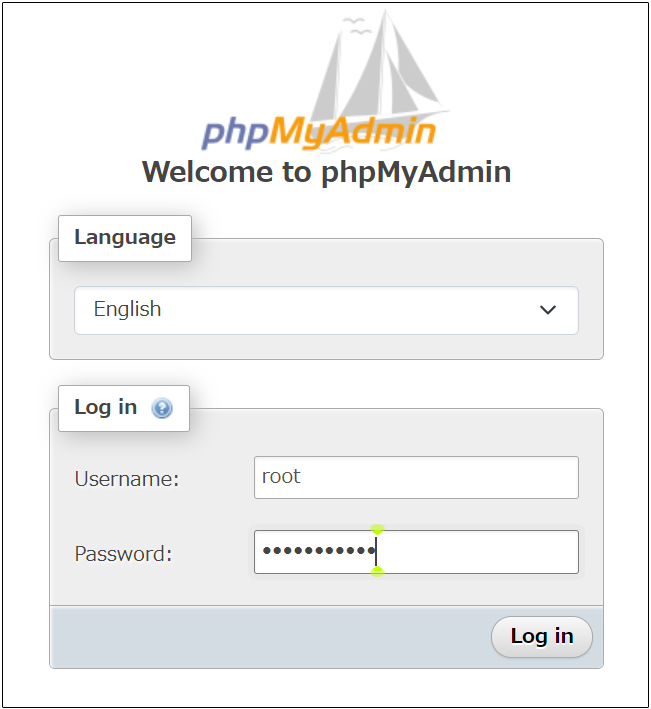
下記phpMyAdminの設定画面が表示される
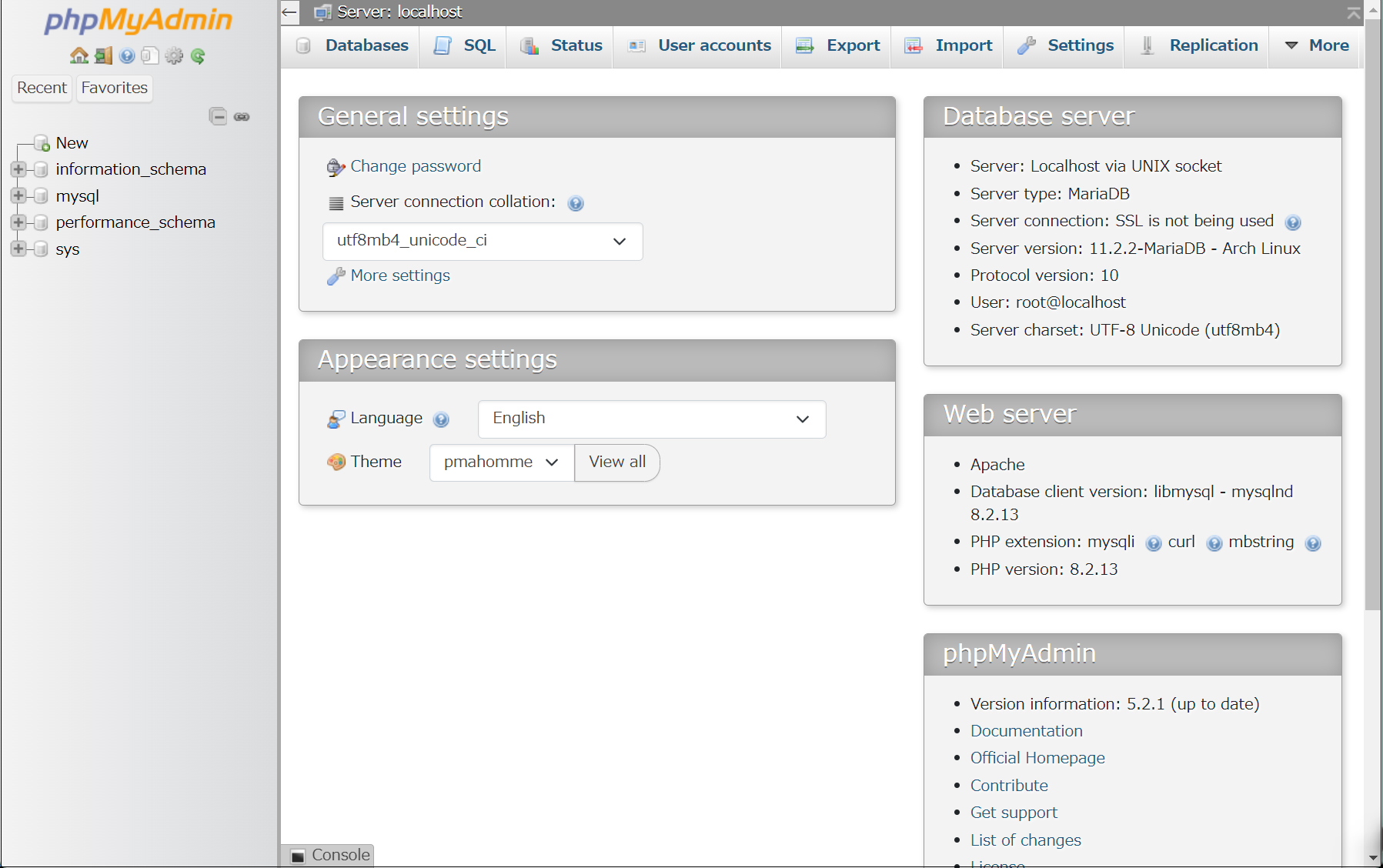
1.3 MariaDB データベース+ユーザー作成例
次にインストールするwordpress用ユーザー、パスワード、データベースを作成してみる
データベース : wp_db
ユーザー : wp_user
パスワード : ?WHxx333Yo
|
1 2 3 4 5 6 7 8 9 10 11 12 13 14 15 16 17 18 19 20 21 22 23 24 25 |
# mysql -u root -p Enter password: Welcome to the MariaDB monitor. Commands end with ; or \g. Your MariaDB connection id is 17 Server version: 10.6.13-MariaDB MariaDB package Copyright (c) 2000, 2018, Oracle, MariaDB Corporation Ab and others. Type 'help;' or '\h' for help. Type '\c' to clear the current input statement. MariaDB [(none)]> create database wp_db; Query OK, 1 row affected (0.000 sec) MariaDB [(none)]> create user 'wp_user'@'localhost' identified by '?WHxx333Yo'; Query OK, 0 rows affected (0.010 sec) MariaDB [(none)]> grant all on wp_db.* to 'wp_user'@'localhost'; Query OK, 0 rows affected (0.001 sec) MariaDB [(none)]> flush privileges; Query OK, 0 rows affected (0.000 sec) MariaDB [(none)]> exit; Bye |
2. WordPress インストール
2.1 必要なライブラリーインストール
|
1 |
# zypper install php-gd php-pdo php-mysql php-mbstring php-simplexml php-curl apache2-mod_php8 |
2.2 WordPressダウンロードとインストール
|
1 2 3 |
# cd /srv/www/htdocs/ # wget http://ja.wordpress.org/latest-ja.tar.gz # tar zxvf latest-ja.tar.gz |
2.3 設定ファイルの編集
|
1 2 |
# cd /srv/www/htdocs/wordpress/ # cp wp-config-sample.php wp-config.php |
|
1 2 3 4 5 6 7 8 9 10 11 12 13 14 15 |
# vi wp-config.php /** The name of the database for WordPress */ define( 'DB_NAME', 'wp_db' ); [データベース名] /** Database username */ define( 'DB_USER', 'wp_user' ); [ユーザー名] /** Database password */ define( 'DB_PASSWORD', '?WHxx333Yo' ); [パスワード] /** Database hostname */ また、最終行に以下の分を追加します。 これをしないと、プラグインを追加するときにFTP接続情報なるものを聞かれます。 define('FS_METHOD', 'direct'); |
/srv/www/htdocs/[web公開ディレクトリー]の下に展開した中身を移動します
|
1 2 |
# cd /srv/www/htdocs/ # mv wordpress/* . |
移動されたことを確認後 wordpressディレクトリーとダウンロードしたlatest-ja.tar.gzを削除
|
1 2 3 |
# cd /srv/www/htdocs/ # rm -Rf wordpress # rm latest-ja.tar.gz |
wordpressディレクトリの所有者をapacheにします。
これをしないとプラグインのインストールなどの際に、ディレクトリを作成できないとか言われてしまします。
|
1 2 |
# chown -R wwwrun:wwwrun /srv/www/htdocs/ # chmod 775 -R /srv/www/htdocs/ |
|
1 |
# systemctl restart apache2 |
2.4 起動確認
ブラウザで http://<サーバー名>/wp-admin/install.php に接続し、ユーザー名、パスワード等必要事項を入力し、インストールを開始してください
通常は、これで下図のWordpress管理画面にアクセスする「ユーザー名」「パスワード」等初期設定インストール画面が表示されますので
Site Title : 任意のタイトル
Username : 任意のユーザー名
Password : 任意のパスワード
Your Email : 管理者のメールアドレス
を入力し、「WordPressをインストール」クリック
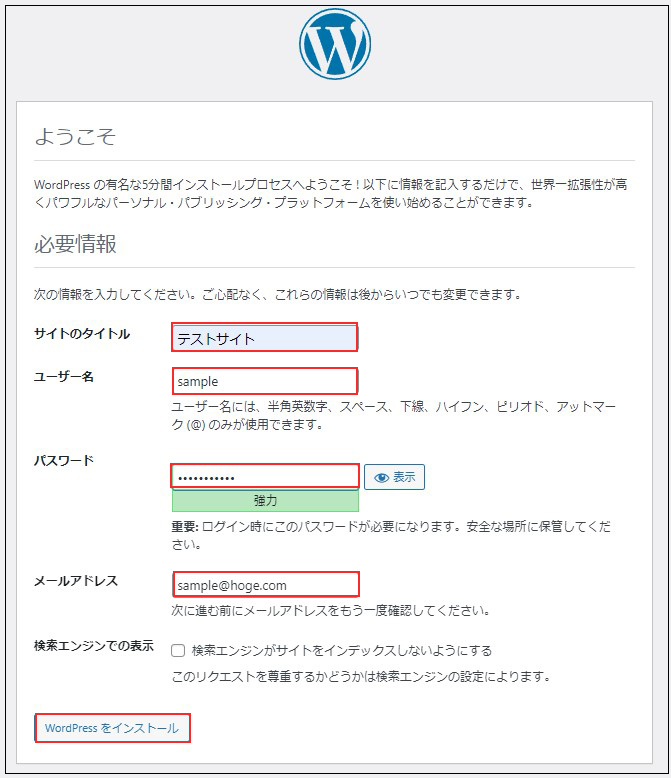
WordPress管理画面への「ユーザー名またはメールアドレス」「パスワード」の入力画面が出ます。
